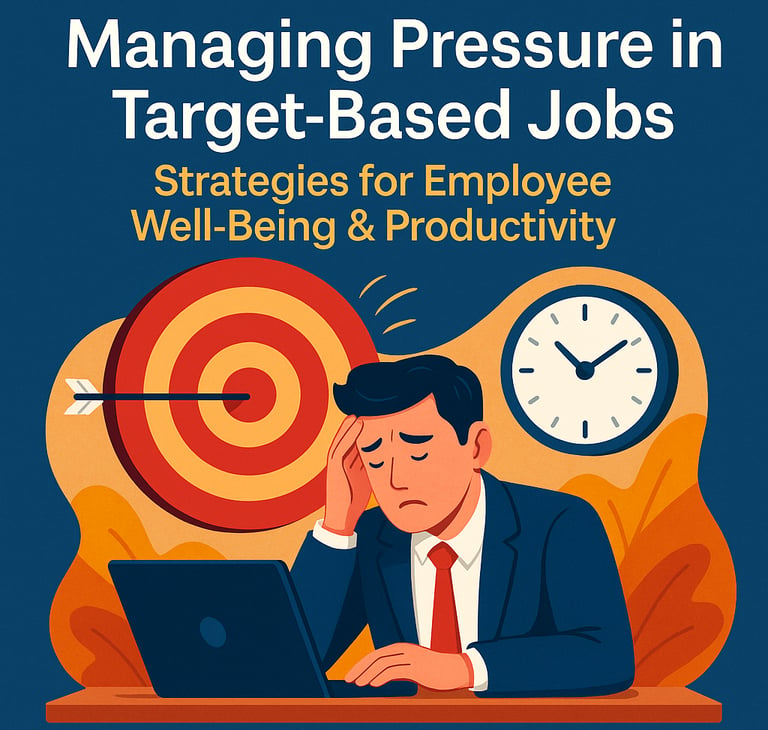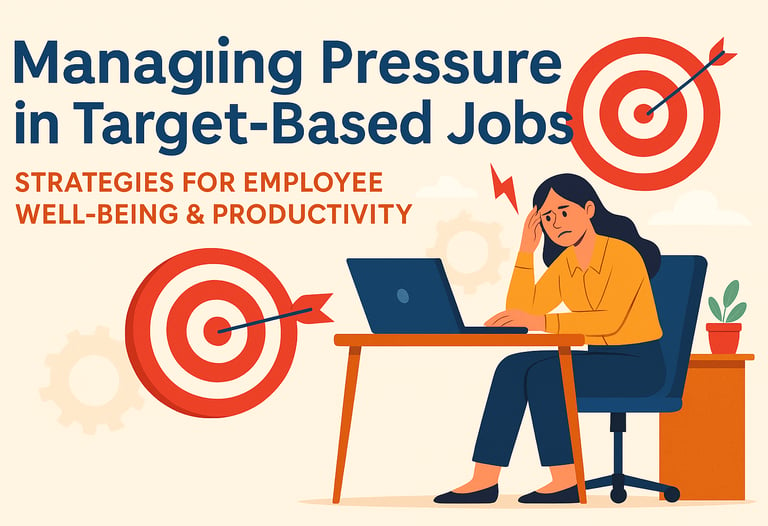Managing Pressure in Target-Based Jobs: Strategies for Employee Well-Being & Productivity
CAREER COUNSELING WITH CHAIFRY
Chaifry
6/3/20256 min read
Introduction
The implementation phase of any project or task is where plans are executed, resources are allocated, and goals are pursued. In target-based jobs—such as sales, project management, or retail operations, this phase is often accompanied by intense pressure from deadlines, stakeholder expectations, and competitive environments. While pressure can sometimes drive performance, excessive or mismanaged pressure can lead to significant negative outcomes for employees, including stress, burnout, and frustration. This article explores the sources of pressure in target-based jobs, its impact on employees’ psychological and physical well-being, the role of work culture in amplifying or mitigating these effects, and strategies to foster a healthier workplace. By focusing on the human element, we aim to provide a comprehensive guide for organizations and individuals navigating the challenges of pressure in implementation processes.


Managing Pressure in Target-Based Jobs: Strategies for Employee Well-Being & Productivity
Sources of Pressure in Target-Based Jobs
Target-based jobs are inherently high-pressure due to their focus on achieving specific, measurable outcomes. The following sources contribute to this pressure:
Deadlines and Time Constraints: Employees are often required to meet strict deadlines, such as sales targets or project milestones, creating a constant sense of urgency. This can lead to rushed decision-making, compromising the quality of implementation.
Resource Limitations: Limited financial, human, or material resources force employees to achieve ambitious goals with inadequate support, increasing stress and reducing efficiency.
Stakeholder Expectations: High expectations from clients, managers, or other stakeholders demand rapid, high-quality results, adding pressure to perform under scrutiny.
Competitive Environment: In industries like retail or technology, the need to outperform competitors or capture market share intensifies pressure, as employees strive to meet or exceed targets.
Organizational Culture: The culture within an organization significantly influences pressure levels. Results-driven cultures, common in target-based jobs, often prioritize outcomes over employee well-being, amplifying stress.
These pressures are particularly acute in environments where targets are tied to performance evaluations, bonuses, or job security, creating a high-stakes atmosphere that can undermine the implementation process.
Impact of Pressure on Employees
The effects of pressure on employees in target-based jobs are profound, affecting both their psychological and physical well-being. Research highlights several key impacts:
Psychological Well-Being: A study on corporate employees found that performance and target pressure significantly increase stress, anxiety, and burnout, negatively affecting mental health. Employees may feel overwhelmed, leading to reduced job satisfaction and disengagement.
Physical Health: Chronic stress can manifest physically, causing headaches, insomnia, musculoskeletal disorders, cardiovascular issues, and fatigue, according to workplace health research.
Reduced Productivity: While short-term pressure may boost output, sustained pressure often leads to decreased performance due to errors, burnout, and lack of focus.
Increased Absenteeism and Turnover: High-pressure environments contribute to higher absenteeism and turnover rates, as employees seek less stressful work conditions. A 2023 Gallup report noted that 43% of employees globally experience burnout, with work pressure as a primary contributor.
Interpersonal Conflicts: Stress can lead to strained relationships among coworkers or with superiors, further disrupting team dynamics and implementation processes.
These impacts not only harm individual employees but also affect organizational outcomes, such as reduced efficiency, lower morale, and increased costs due to turnover and absenteeism.
Work Culture in Target-Based Environments
Organizational culture plays a critical role in shaping how pressure is experienced and managed in target-based jobs. Two distinct cultural types—market and clan cultures—have different effects on employee stress and performance.
Market Culture
Market cultures, prevalent in target-based environments, emphasize results, competition, and achieving external objectives. These cultures prioritize meeting quotas and targets, often tying rewards to performance outcomes. While effective for driving profitability, market cultures can increase stress by placing heavy demands on employees. A study in the International Journal of Environmental Research and Public Health found that market cultures negatively affect employees’ adaptability, leading to higher stress levels, particularly for those less equipped to handle external pressures. However, employees with strong customer orientation skills—those who excel at meeting client needs—tend to experience lower stress in market cultures, as they feel more in control of their work processes.
Clan Culture
In contrast, clan cultures are characterized by flexibility, collaboration, and a focus on internal relationships. These cultures support adaptability, allowing employees to adjust to changing demands, which reduces stress. The same study noted that employees with high adaptability competency in clan cultures reported significantly lower stress levels (mean stress score of 3.47 in clan cultures vs. 4.42 in market cultures for low-adaptability employees). By fostering a supportive environment, clan cultures can mitigate the negative effects of pressure, making them a valuable model for target-based organizations seeking to balance performance and well-being.
Toxic Work Cultures
A toxic work culture, marked by poor communication, lack of recognition, or favoritism, exacerbates pressure and frustration. Research indicates that toxic cultures are 10.4 times more likely to predict turnover than compensation issues, contributing to the “Great Resignation” phenomenon. Employees in such environments often feel disconnected from organizational goals, leading to confusion, low morale, and reduced productivity.
Different organizational cultures have distinct characteristics that influence employee stress and competency. A market culture, which is results-oriented, competitive, and externally focused, tends to increase stress—particularly in terms of adaptability—while supporting competencies like customer orientation. In contrast, a clan culture, with its collaborative, flexible, and internally focused nature, helps reduce stress and enhances adaptability among employees. On the other hand, a toxic culture, marked by poor communication and a lack of recognition, significantly heightens stress and frustration without contributing to any positive employee competencies. These differences highlight how workplace culture directly affects well-being and performance.
Frustration at the Workplace
The relentless focus on productivity in target-based jobs often leads to significant frustration among employees. This “productivity culture” places the burden of optimization on individuals, creating a conflict between personal well-being and professional demands. The New Yorker article “The Frustration with Productivity Culture” highlights this growing discontent, noting that employees feel exhausted by the expectation to constantly maximize output. Key sources of frustration include:
Overwhelm and Burnout: The pressure to meet ambitious targets can lead to burnout, characterized by cynicism, detachment, and reduced performance. Employees report feeling like they must ignore personal needs to produce value for organizations.
Lack of Systemic Support: Historically, productivity improvements came from system optimizations (e.g., assembly lines). In modern knowledge work, however, the burden has shifted to individuals, leaving them to manage their own efficiency without adequate support.
Unrealistic Expectations: Stretch goals, designed to be ambitious, are often misinterpreted as mandatory, leading to stress and a sense of failure when not met. Clear communication about the purpose of such goals can mitigate this frustration.
This frustration is particularly acute in target-based jobs, where employees are constantly measured against quotas, leading to a sense of being undervalued or dehumanized. For example, retail employees at Target reported that the pressure to meet daily targets eroded the appeal of higher wages and benefits, contributing to stress and dissatisfaction.
Strategies for Mitigating Pressure and Frustration
To address the challenges of pressure and frustration in target-based jobs, organizations can adopt several strategies to create a more balanced and supportive work environment:
Foster a Balanced Culture: Incorporating elements of clan culture, such as collaboration and employee support, can reduce stress while maintaining focus on targets. Leaders should prioritize relationships and adaptability alongside results.
Clear Communication and Goal Setting: Setting realistic, well-defined goals and communicating their purpose clearly can prevent misunderstandings and reduce pressure. Regular feedback and recognition of achievements boost morale without adding stress.
Employee Wellness Programs: Offering mental health support, stress management workshops, and flexible work arrangements can help employees cope with pressure. For example, providing gym membership or therapy access has been shown to improve well-being and productivity.
Systemic Productivity Optimization: Shifting the focus from individual to systemic productivity, as seen in agile methodologies like scrum or kanban, can alleviate the burden on employees. This approach, rooted in software development, optimizes processes rather than individual output, reducing psychological strain.
Leadership and Recognition: Leaders should model healthy work behaviors and prioritize employee well-being. Recognizing outstanding work and celebrating achievements fosters a positive culture, reducing frustration and enhancing engagement.
To foster a healthier and more productive work environment, organizations can adopt several key strategies. A balanced culture that incorporates collaboration and support can reduce stress while improving employee adaptability. Clear communication, including setting realistic goals and providing constructive feedback, helps lower pressure and boost morale. Implementing wellness programs that offer mental health resources and stress support contributes to improved well-being and overall productivity. Systemic optimization, which focuses on streamlining processes, reduces individual burdens and minimizes frustration. Finally, leadership support—where managers model healthy behaviors and recognize employee achievements—enhances engagement and decreases turnover. Together, these strategies create a more sustainable and positive workplace dynamic.
Conclusion
Pressure in target-based jobs is a double-edged sword: it can drive performance but, if mismanaged, leads to significant negative impacts on employees’ well-being and organizational outcomes. Market-oriented cultures, while effective for achieving targets, often amplify stress and frustration, particularly when employees lack systemic support or adaptability. By fostering balanced cultures, implementing clear communication, prioritizing employee wellness, and optimizing systems rather than individuals, organizations can mitigate these challenges. A supportive work environment not only reduces stress and frustration but also enhances productivity, engagement, and retention, creating a sustainable approach to implementation in target-based jobs.


